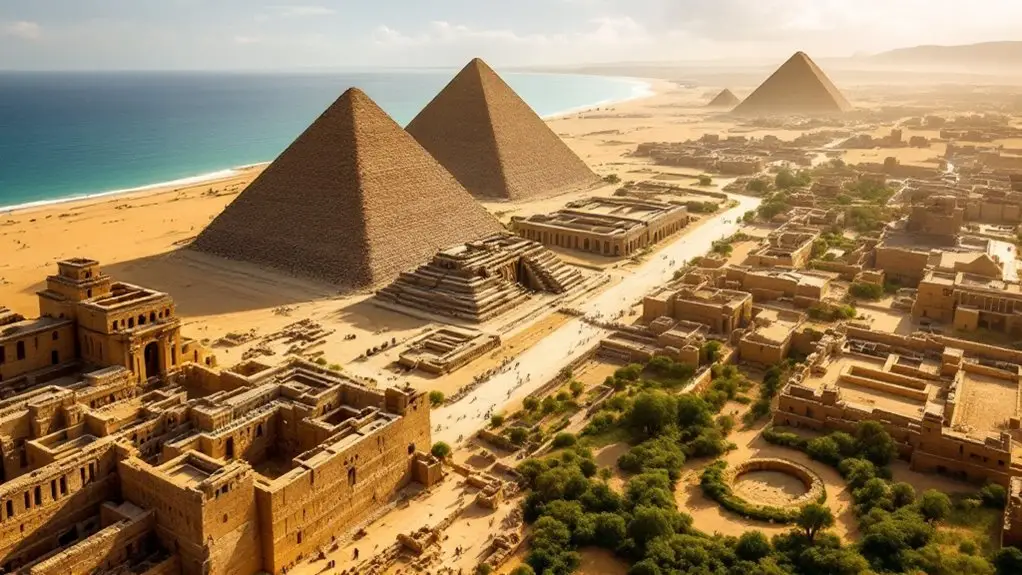When you consider Africa's rich history, several archaeological sites stand out as must-visit destinations. Each location, from the Olduvai Gorge in Tanzania to the Valley of the Kings in Egypt, offers unique insights into the continent's past. You'll uncover stories of human evolution, ancient civilizations, and architectural marvels that shaped societies. As you explore these sites, you'll find yourself pondering how they've influenced modern culture and history. Curious about which five sites are essential for your journey? Let's explore these remarkable places together.
Key Takeaways
- Olduvai Gorge, Tanzania, is vital for human evolution studies, offering insights into early human behavior and development over millions of years.
- The Valley of the Kings, Egypt, features ancient tombs with intricate architecture and artifacts, crucial for understanding ancient Egyptian burial practices.
- Gedi Ruins in Kenya showcase a 13th-century Swahili settlement with unique architecture and evidence of extensive trade connections.
- Laetoli, Tanzania, preserves ancient footprints that provide critical evidence of early human bipedalism and social behavior dating back 3.6 million years.
- Sterkfontein Caves, South Africa, are key for paleoanthropological research, yielding significant hominid remains that enhance our understanding of early human development.
Olduvai Gorge, Tanzania
Olduvai Gorge, often dubbed the "Cradle of Mankind," stands as a monumental site in the study of human evolution. Located within Serengeti National Park in Tanzania, this archaeological treasure trove offers a continuous record of human development spanning from approximately 2.1 million years to 15,000 years ago.
Here, you'll find the remarkable fossil remains of over 60 hominins, including a significant skull fragment discovered by paleo-anthropologist Mary Leakey in 1959.
The site's archaeological discoveries extend beyond fossils, revealing various stone tools that illustrate early human behavior as both scavengers and hunters. These findings provide essential insights into the social dynamics and survival strategies of early human groups.
Olduvai Gorge's significance is underscored by its critical role in shaping our understanding of human evolution, leading many to refer to it as the "Cradle of Humankind."
As you explore this area, you'll witness firsthand the profound impact these discoveries have on our comprehension of where we come from.
Olduvai Gorge isn't just an archaeological site; it's an important chapter in the story of humanity.
Valley of the Kings, Egypt
Nestled on the west bank of the Nile near Luxor, the Valley of the Kings serves as a monumental tribute to ancient Egyptian beliefs about the afterlife and the elaborate burial practices of its rulers. This site contains the burial sites of pharaohs and nobles from the 2nd millennium BC, featuring 63 known tombs, many of which have been plundered over the centuries.
The valley, used as a royal burial ground during the New Kingdom of Egypt (circa 1550–1070 BC), showcases the significance of elaborate funerary customs in ancient Egypt. Notable tombs, such as that of Tutankhamun, discovered in 1922, provide invaluable insights.
Tutankhamun's tomb, largely intact, revealed a wealth of artifacts that enhance our understanding of ancient Egyptian culture.
The architecture of these tombs reflects advanced construction techniques, with intricate wall paintings and hieroglyphs that narrate the deceased's journey into the afterlife.
Recognized as a UNESCO World Heritage Site since 1979, the Valley of the Kings continues to offer profound knowledge about ancient Egyptian civilization and its burial customs, making it an essential destination for anyone interested in history.
Gedi Ruins, Kenya
Dating back to the 13th century, the Gedi Ruins on Kenya's coast offer a fascinating glimpse into a once-thriving Swahili settlement. This archaeological site reveals significant insights into the culture and daily life of its inhabitants through various elements:
- Architectural Style: The impressive structures include a large mosque, an elaborate palace, and numerous stone houses, showcasing the unique architectural style of the coastal Swahili civilization.
- Trade Connections: Excavations have uncovered artifacts indicating trade links with regions as far as Spain, Venice, India, and China, reflecting Gedi's role in global commerce.
- Archaeological Evidence: The ongoing excavations continue to yield valuable archaeological evidence that enriches our understanding of the settlement's history.
- Climatic Changes: Gedi was abandoned in the late 17th century, potentially due to climatic changes or shifts in trade routes, marking a significant turning point in its history.
These aspects collectively illustrate the importance of the Gedi Ruins, not only as a historical site but also as a reflection of the vibrant life and connections that once existed in this Swahili settlement.
Laetoli, Tanzania
Uncovering the ancient footprints at Laetoli, Tanzania, reveals a remarkable window into the lives of our early ancestors. Discovered in 1976 by paleoanthropologist Mary Leakey, these footprints, preserved in volcanic ash, date back approximately 3.6 million years ago. This significant archaeological site provides essential evidence of early human bipedalism and illustrates the adaptive strategies of our ancestors.
The variety of footprints, including those of other animals like hyenas, rhinos, and gazelles, showcases the rich ecosystem of that time. Researchers regard Laetoli as fundamental for studying the evolution of human locomotion and social behavior among early hominids, offering insights into how these ancient beings interacted with their environment.
While Laetoli primarily focuses on the evidence of early bipedalism, it also contributes to our broader understanding of the evolutionary narrative in sub-Saharan Africa. The findings here complement other significant discoveries across the continent, helping to paint a picture of human development over millions of years.
Visiting Laetoli allows you to connect with a pivotal moment in our evolutionary history, reminding us of the intricate journey that shaped modern humanity.
Sterkfontein Caves, South Africa
The Sterkfontein Caves in South Africa stand as a cornerstone of paleoanthropological research, offering invaluable insights into human evolution. As part of the Cradle of Humankind UNESCO World Heritage Site, these caves have been a focal point for hominid fossil discoveries since the mid-1930s.
You'll find that the caves contain:
- Approximately 500 hominid remains, providing a rich dataset for analysis.
- Notable finds like "Mrs. Ples," one of the most complete Australopithecus skulls.
- "Little Foot," a remarkably preserved early hominid skeleton, highlighting the exceptional preservation conditions.
- Unique limestone formations that enhance their geological significance.
Dating back around 2 to 3 million years, the hominid fossils discovered here are critical for understanding the behavior and development of early hominins.
The Sterkfontein Caves are recognized as a paleontological treasure, contributing greatly to our knowledge of ancient environments and the origins of human ancestors.
Frequently Asked Questions
What Is the Most Ancient Site in Africa?
When exploring Africa's most ancient site, consider the archaeological significance of places like Olduvai Gorge.
You'll find historical artifacts that illuminate early human evolution.
Preservation efforts are vital in maintaining these sites, while advanced excavation techniques reveal deeper insights into ancient civilizations.
The site's accessibility enhances its educational value, impacting tourism positively.
Understanding this cultural heritage not only enriches your knowledge but also highlights the importance of safeguarding these invaluable resources for future generations.
Which Country in Africa Has the Best History?
When considering which country in Africa has the best history, you'll find that it depends on the criteria you prioritize.
Countries like Egypt and Ethiopia showcase ancient civilizations and rich cultural heritage through significant archaeological discoveries. Their historical significance is complemented by preservation efforts and site management, enhancing their tourism impact.
Additionally, the educational value of these sites illuminates local traditions, making them essential for understanding Africa's diverse history and heritage.
What Is the Most Visited Archaeological Site in the World?
When pondering the great mysteries of history, you can't ignore the Great Wall of China, the most visited archaeological site, attracting around 10 million tourists annually.
While sites like Machu Picchu and Pompeii showcase rich cultures and preservation efforts, the allure of Angkor Wat and Petra draws explorers seeking ancient wonders.
Similarly, Chichen Itza and the Colosseum invite you to explore their fascinating histories, each reflecting unique aspects of humanity's past.
What Is the Best Archaeological Site?
When considering the best archaeological site, you'll want to evaluate its significance in revealing ancient civilizations.
Look at the excavation techniques employed, the preservation methods of historical artifacts, and the archaeological discoveries made.
The site's cultural heritage can also impact local communities and tourism.
Ultimately, the best site is one that not only showcases historical importance but also fosters understanding and appreciation of the past while benefiting present-day society.
Conclusion
Visiting Africa's archaeological sites offers a unique opportunity to connect with our shared human history. While some may think these locations are too remote or challenging to access, many are well-served by local guides and infrastructure that enhance your experience. By exploring sites like Olduvai Gorge and the Valley of the Kings, you not only gain a deeper understanding of ancient civilizations but also witness the rich tapestry of human evolution. Don't miss out on this enchanting journey.








